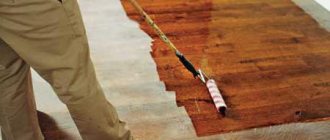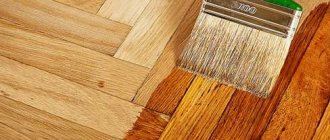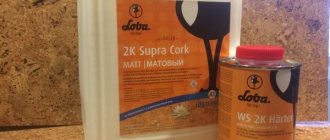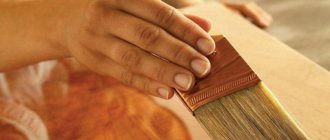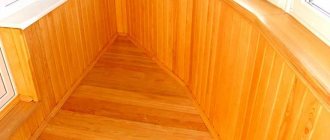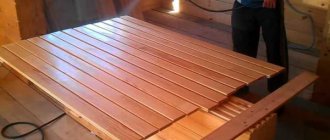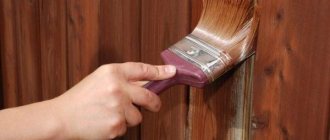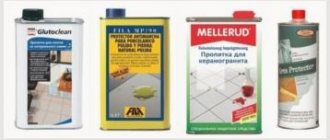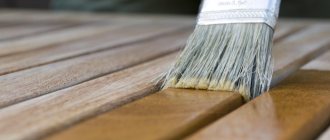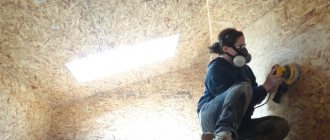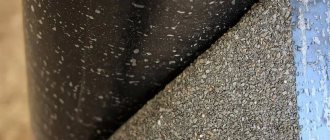Types of varnishes
Any varnishes are a transparent or translucent material that is used to coat wood in order to protect it and improve its external aesthetic qualities. Before choosing what varnish to coat the lining inside the house with, you need to compare the advantages and disadvantages of all products of this type.
Photo - shades of varnish for lining
These materials are classified according to their composition, properties and area of use. There are varnishes for interior and exterior use; they differ from each other in some qualities (for example, outdoor coating should be indelible) and smell. Depending on the place of application, coatings are divided into:
- Parquet. Used to cover wood on floors. You can choose any color and properties (glossy, matte surface). The key difference from other products in this series is their high resistance to mechanical stress: friction, walking, etc.
- Furniture. For finishing furniture, special compounds are used that provide long-lasting shine and unchanged color of wood over many years of use. Most of them are made on a wax basis;
- Construction boats. They have an increased coefficient of resistance to moisture, which allows them to be used in shipbuilding. Many craftsmen use such products to decorate utility rooms (bathhouses, garages) or facades of residential buildings;
- Decorative. The widest group. Intended solely for room decoration. This varnish can be glossy or matte. Often indelible with water and with excellent antiseptic properties. It is used for covering walls in residential buildings, utility rooms (loggias, cottages, steam rooms, etc.), and sometimes for finishing facades.
Photo - matte shine
Varnish is a coating for lining, which, depending on the main components, has not only decorative, but also protective properties. Depending on the composition they are :
- Alkyd;
- Acrylic;
- Nitrovarnishes;
- Oily;
- Epoxy;
- Polyurethane.
Let's look at the features of each group. Alkyd varnishes for coating wooden lining can be used on balconies, hallways, and living rooms. They are universal and have high resistance to external aggressive factors (high humidity, temperature changes). These paints and varnishes penetrate deep into the wooden structure, so they take a very long time to dry - sometimes the hardening time of the coating reaches up to 3 days. Disadvantages also include the high cost of the coating and the likelihood of fire.
Photo - nitro varnish sprayer for lining
Oil varnishes are also called impregnation. They are rarely used independently; they provide primary wood processing. Depending on the oil and resin in the composition, the coating can have different colors: from light brown to dark chocolate. After hardening, they form a hard film on the wall or ceiling that is easy to clean. Further processing is carried out on top of it. Among the advantages: moisture resistance, protection of wood from exposure to UV rays, extension of the durability of the coating. The disadvantages include a high level of fire hazard.
Epoxy varnish can be used to paint walls, ceilings, floors, furniture and other surfaces. It has excellent properties of strength and resistance to high humidity. Thanks to this versatility, it is very popular among professional and home craftsmen. You can choose any colors, it is easy to use and apply, and is very flexible. Among the disadvantages is the relatively high price of the coating - from 3 dollars per square meter (at optimal consumption).
How to paint the lining?
The products involved in the coating process are correctly represented as: varnishes
on different bases, special
paints
and modern
impregnations
. Each of them can be used to process lining on the balcony. Let's list the main types of what can be used to cover eurolining on a loggia and balcony, and in the room as a whole.
Varnishes for lining
Water based varnish. The advantage of this type is, first of all, determined by safety: water-based varnish is made exclusively from pure materials and components. It dries quickly and does not have a characteristic odor.
However, such a product can be used on a surface that is protected from the direct influence of aggressive weather conditions, that is, on a glazed balcony indoors. Among the negative features: the level of protective properties of water-based varnish is very low compared to the series below.
Before use, dilute the varnish with alcohol to the required consistency. This is one of the most popular and affordable means for processing lining.
Alkyd varnish. The best option for regions with high humidity. You can paint both the outer part of the lining on the balcony and its inner side. The composition of this series is moisture-resistant; it transforms the surface, creating a durable protective coating for it.
The disadvantages of alkyd-based varnish include a rather pungent odor, as well as an excessively long drying time. The main advantage in operation is the excellent level of impact resistance.
Polyurethane varnish. Purpose – exclusively external processing of lining. A polyurethane-based varnish that incorporates all the main advantages of the series listed above: moisture resistance, frost resistance, durability, excellent ultraviolet protection and quick drying.
However, its main specificity is the release of harmful toxic substances and a specific odor. Actually, it is for this reason that it is only suitable for exterior decoration. When working with this varnish, be sure to use a respirator or a thick gauze bandage.
Paints for lining
Oil based paint. This substance dries for quite a long time, but at the same time it has a number of worthy advantages, among which are: good absorption and durable protection. The latter allows the wood to “breathe”. Its operation is possible indoors and outdoors.
The treated surface becomes moisture resistant, it does not succumb to old age, since it does not fade or crack. To process the lining, you can choose any well-known brand of oil paint offered on the market.
It is recommended to paint the lining with a similar composition in a double layer
. This substance forms a stable moisture-resistant film, the distinctive quality of which is good frost resistance. It is used for outdoor work: the surface treated with it does not give in to deformation and dryness, maintaining its original appearance for a long time.
Facade paints. These are alkyd resins and water-dispersed substances, nitro paints and products with polymer additives. Elastic facade paints have a good level of moisture resistance, they can be applied to the surface without problems and are durable.
A thick layer of paint can mask minor flaws in wood. If the lining is difficult to clean from dust and old coating, you can use any composition of this category for painting.
Impregnations for lining
stain
is the simplest method of protecting wood. The color range of this product is not particularly diverse, but such a solution is both a cheap and worthy option. High-quality impregnation protects wood from rotting processes, mold and serious fungus.
Wax-based impregnations
Recommended for use in areas with high air humidity. Such products create a moisture-resistant film, giving the surface a soft matte or modern glossy shine. This coating has good heat- and frost-resistant characteristics.
Application
To renew the wall covering, you need not only to know how to remove varnish from the lining, but also how to use the coatings correctly. To begin with, the walls (floors, ceilings) are washed; for this, take a damp cloth with special cleaners for wood. This is necessary to remove dust and dirt from the wood pores.
Next, the old coating layer (if any) is removed or the lining is sanded. For this purpose, both special grinding machines and low-abrasive sandpaper and metal brushes are used. This is necessary to level the surface and eliminate nicks. After this, you need to paint the wood with drying oil. It can be bought at any hardware store. The drying oil will fill microcracks in the lining and help improve adhesion; after the drying oil has dried, a primer is applied to the walls.
Photo - grinding machine
How to paint lining with varnish:
- Movements should go along the tree structure, preferably from top to bottom. The first layer is made dense, but without streaks;
- For painting, you can use both brushes and rollers, but it is more convenient to work with brushes. The material of the working part of the instrument must be made of natural wool;
- Experts recommend doing 3 layers of varnish, the last being the thinnest. It is leveling. Afterwards the room is left to dry and ventilate. Once every 3 years, the coating will need to be renewed to avoid cracks and chips.
You can buy varnish for lining at any hardware store; on average, the price varies from $6 per can. The cost may vary depending on the brand and purpose of the product.
Lining is one of the most commonly used materials nowadays. It usually has an outer protective coating, so many people think that just installing it is enough and nothing else is required. However, in order to improve the resistance of this finishing material to negative external factors, as well as to extend the life of the boards, it is advisable to use lining varnish. This composition protects the surface and also makes it visually attractive.
Typically, high-quality lining is made from natural wood, after which it is coated with special impregnations, so this material already has some protection. But if you apply a suitable varnish to the surface, the aesthetic properties will increase and the protection of this facing material will increase. Thanks to the finishing with transparent varnish, you can preserve for a long time and even highlight the natural texture and shade of wood. It will not change under the negative influence of ultraviolet rays, especially if the lining is used not inside the house, but on the balcony.
Nowadays, lining is used not only on balconies and under the roof space, but also inside the house, where it looks very attractive. Thanks to the coating with a pigmented type of lining varnish, you can make the shade more saturated. And if you apply it to a natural wooden surface, you can completely transform the wood, making it more solid and expensive. Many people have a question: what kind of varnish can be used to coat the lining inside the house and on the balcony? Next, popular types of varnish compositions will be considered.
Treat with acrylic
This method is not only fashionable today, but also durable. A surface coated with acrylic will last up to 10 years without renewal. In addition, acrylic paint is easy to use, it dries quickly, has virtually no odor, and through this coating the structure of the wood and its natural shade are visible. True, the price of such a coating is much higher than varnishes and oil paints.
Before painting the surface, we carry out preliminary preparation: if there was paint on the lining and it is in good condition, then just wash the wood with alkali; if there are mold stains or the wood was varnished, then the old coating must be cleaned off. Then coat the surface with an antiseptic and only then paint.
Varieties
To process wood on the balcony and at home, the best option is an environmentally friendly and harmless varnish composition, preferably one without an unpleasant odor or toxic components. Experts say that it is better to paint a wooden base with water-based varnish.
Water-soluble types of varnish mixtures can be safely applied inside living rooms; such products do not contain solvents, so they do not have a specific unpleasant odor. In addition, water-based varnish is hypoallergenic, safe for human health, has a long service life, and can be used to cover ceilings and walls, as well as various ceilings, partitions, balcony elements and loggias.
There are one-component and two-component water-soluble varnish mixtures. What is the best varnish to use for lining? Two-component varnishes must be mixed before use; they create a better protective layer. Applying varnish on the balcony and at home is quite easy; it does not require special knowledge or skills in the field of finishing; it is easy to work with the varnish mixture. Depending on the structure of the wood, its absorbency, as well as how many layers the composition will be applied, the consumption of varnish will depend.
Water-soluble types of varnishes for lining have many advantages:
- environmentally friendly and non-toxic;
- do not have an unpleasant odor, so you can use this varnish for lining inside the house;
- are fireproof;
- not sensitive to sunlight, after many years the protective coating will not turn yellow and will not change the color of wooden products;
- have an excellent adhesion rate, that is, they adhere well to wood;
- have a good level of physical and mechanical protection;
- very easy and quick to apply;
- can be tinted in any available color.
Impregnations
In addition to varnish mixtures, special impregnations are also used to protect the lining. They penetrate deeply into the surface of the wood and create a reliable protective layer. Quite often, impregnations or stains that have a wax base are used on balconies. The simplest impregnation option is stain, which is quite inexpensive, and its characteristics are practically no worse than expensive materials.
Different types of stains have an alcohol, acrylic, oil and water base. In addition, powder, gel and ready-to-use stains are produced; they are intended for either external or internal use. Impregnation, which has a wax base, protects the wood from high air humidity, so the wood does not begin to rot. The protective layer formed on the surface withstands temperature changes, the surface becomes very attractive. Impregnations are often used to protect the lining from harsh climates, large temperature fluctuations and high humidity; they are applied to the internal surfaces of saunas and baths.
Cover with liquid plastic
This is a new way of processing lining, more often it is used for external work: terraces, gazebos, balconies. Liquid plastic is resistant to external factors, does not fade in the sun, water flows like plastic and does not penetrate into the wood, although the wood itself loses its ability to “breathe”. You can choose any color, from semi-transparent to radically bright.
It is easy to apply to wood, just like varnish in 1-2 layers, having previously cleaned and treated the surface.
Before choosing a method for updating the lining, you need to pay attention to which room or surface this or that method is more suitable for, then the wooden finish will last a long time.
Source
Varnishing rules
In order for acrylic varnish or another type of varnish composition to adhere firmly to a wooden paneling indoors or outside a balcony, loggia, veranda or terrace, you must adhere to certain rules for applying varnish mixtures. Before applying any type of solution, such as acrylic varnish, polyurethane or alkyd, the surface must be cleaned and sanded.
Then, in order to reduce the consumption of expensive varnish, as well as improve the adhesion (adhesion) of the varnish mixture to the lining, experts recommend priming the base. Also, thanks to priming, the protective characteristics of the decorative coating are improved. If a water-based varnish is applied, then the primer should be the same in composition so that it interacts as well as possible with the varnish solution.
When the impregnation or primer has dried (usually this takes 4-24 hours, depending on the temperature and humidity), you can begin to apply varnish to the lining. The application process can be carried out using a brush, roller, spray or swab. A swab and brush are used when you need to varnish a small surface area, a roller and a spray gun allow you to very quickly varnish a large number of square meters of lining.
Before applying the composition, it must be thoroughly mixed. If the varnish mixture is very thick, it can be diluted according to the instructions, either with water or thinner. More liquid solutions spread over the surface much better, and the layer is not very thick. Do not exceed the dilution ratio specified in the technical specifications or instructions.
Important! If pigment dye or tint is added to the varnish, it is important to thoroughly mix the composition to obtain a uniform consistency in viscosity and shade.
Apply the varnish to the surface of the lining carefully so that the mixture does not get on the skin, eyes, or nearby objects. You need to work in a respirator, goggles and gloves. If varnish gets on your skin or other objects, it must be washed off immediately with water before it dries, otherwise it will be much more difficult to remove. It is advisable to varnish in several layers to ensure maximum surface protection. There is no need to save money when choosing paint and varnish products; they must be of high quality, because the success of varnishing and subsequent operation of the lining depends on this.
To protect the interior upholstery of a house made from clapboard, various compounds should be used. Often, in order to protect against mechanical and other damage and moisture, they use varnish on the lining, which will extend the life of the panels, improving their appearance. The advantage of such a coating is that the composition can be selected according to the appropriate shade, which will allow it to convey a certain depth of coverage and shine.
Secrets of decorative wood staining: techniques and tricks
City dwellers want to preserve the natural color of wood as much as possible. For those for whom wood in the house is a boring everyday thing, paint the interior lining in some unusual color. Modern paintwork materials allow you to achieve different effects. For example, textured or brushed lining, but in two colors. This technique is often used in loft style interiors.
Brushed lining in two colors is an excellent choice for decorating walls
The trick is to apply two layers of different colors. The first layer is a dark color, the second is a light or brighter color. After playing with colors and the order of their application, you can create your own version. Watch the video - how to get lining brushed in two colors.
Painting in two colors may not be the same. You can make the recesses a darker color, and only slightly tint the face (front part) or do everything exactly the opposite. The result is a striped wall made of clapboard - the effect of a slatted wall.
Protection procedure
Typically, coniferous and hardwood panels, which are subject to the aging process, are used to upholster the interior walls of rooms. Even if the type of wood was chosen, depending on the load planned for the room. However, such an undesirable aging process can be significantly slowed down.
Applying a protective layer to the lining
Speaking about the list of negative factors that have a detrimental effect on the lining, the following should be highlighted:
- FACTOR 1: Increased solar radiation.
- FACTOR 2: High air humidity, contact of wood with water is especially detrimental.
- FACTOR 3: Pest bugs.
- FACTOR 4: Mechanical damage.
- FACTOR 5: Growth of microorganisms on the surface of the lining.
Application of water-based varnishes
Features of such compositions
Most often, compounds such as lining varnishes, which are usually used indoors, are used to protect wood.
Interior varnish
Aqueous compositions used for processing the internal cladding of lining are made on an acrylic base, as well as on a polyurethane base.
According to their composition they are divided into:
- Consisting of one component . They are characterized by minimal strength, do not last too long, but are easy to handle;
- Consisting of two components . These components are the base and hardener. This composition is positioned as a varnish for eurolining, since its protection is maximum.
The coatings do not contain a solvent, which allows them to be considered highly environmentally friendly products. As for the composition consumption and how to varnish the lining, it depends on the brand, as well as on the thickness with which it is applied.
Below are approximate quantity calculations:
- For planed wood - approximately 1 kg of varnish per 16 square meters;
- For sawn wood - approximately 1 kilogram of composition per 6 square meters.
The positive aspects of water-based varnishes
Speaking about water-based varnishes for wooden lining, we should highlight their positive aspects:
Pinotex brand varnish
- PLUS 1: Safety from a fire point of view , since the water base is not capable of supporting combustion.
- PLUS 2: Highly environmentally friendly. This is due to the absence of any toxic substances in the composition. This allows them to be used indoors without harm to health.
- PLUS 3: Easy to use. Instructions from the manufacturer will help you paint the lining yourself. Moreover, you can do this with your own hands, without resorting to the help of specialists.
- PLUS 4: Resistance to yellowing when the coating is exposed to ultraviolet rays.
Varnish coating of lining
An additional advantage of this varnish is its large transfer area. This is especially important if the application is by spraying, as nothing will be left inside the spray equipment.
Negative sides
When choosing which varnish is best for lining, study not only the pros, but also the disadvantages of this type of coating. The choice of paint also requires a balanced approach.
Important disadvantages include:
- MINUS 1: Long wait for drying (up to a day).
- MINUS 2: The price is high.
- MINUS 3: At the moment of drying, humidity and temperature changes have an effect;
- MINUS 4: During storage of the composition, you should pay attention to the storage conditions: do not freeze.
It is important! In principle, if the varnish is expensive and of high quality, it can be frozen or thawed several times. However, it is better to do without experiments.
In fact, water-based varnish for wooden lining is one of the most successful options. After all, the shortcomings described above are not fatal.
How to apply water-based varnish
Preparation process
The panels must first be prepared for painting.
Accordingly, before covering the lining, we:
- STEP 1: We carry out the process of cleaning the lining from dust; it is necessary that there is no dirt, fungal formations, or other types of microorganisms on the surface of the lining.
- STEP 2: We sand the walls of the room, you can use simple sandpaper. It is not at all necessary to use grinding machines. Sanding is necessary in order to ultimately obtain a perfectly smooth surface, the application of a topcoat to which will give a mirror-like shine effect.
If you want to get the effect of a mirror surface (similar to the photo), you should use the so-called wet grinding, before which the lining must be moistened and allowed to dry after processing.
Carrying out varnishing with aqueous composition
You can apply clapboard varnish inside the house using a roller, brush, sprayer or swab, depending on the availability of places. Accordingly, the less accessible the space, the smaller the brush is needed so as not to go beyond the edges to be painted.
However, the following tips will be helpful:
- TIP 1: Colorless varnish or impregnation can be applied with a brush or roller (video), the main thing is to do it along the grain. If the varnish is tinted, then a sprayer or swab is needed.
- TIP 2: If the varnish is tinted, then it requires thorough mixing until its color becomes uniform.
- TIP 3: If you need to dilute the composition, then you need clean water, without any organic solvents.
Applying varnish with a brush
- TIP 4: In order to add depth to the surface, you should first treat the lining with a dark-colored varnish, and then with a transparent one, to which 5 to 10% tinting can be added.
- TIP 5: Several thin layers are preferable to one thick one.
Adviсe
- Do not use a thick layer, as it will blur and the service life will be short. It is better to paint in several thin layers.
- Use thin brushes in hard-to-reach places.
- Use a paint roller as it will not leave lint.
- Each product must be applied to the lining in several layers. Usually one or two, but it’s better to check with the store.
- When processing, move the brush along the board without tearing it off. Only the tips of the fibers should touch the lining. There is no need to press with great force.
It will be more difficult to update old lining on a terrace or on a cold balcony, so it is worth purchasing a special product that is resistant to temperature changes (how to beautifully cover a balcony or loggia with lining?). When processing building materials in a country house or in a heated room with normal humidity, no special requirements are imposed. It is enough that the materials to be painted are dry.
